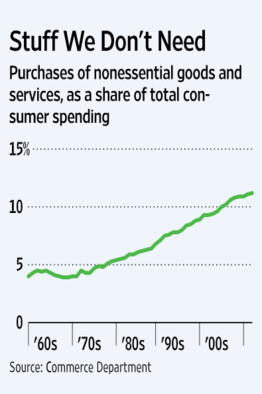It’s no wonder the US economy continues to grow despite high unemployment, record household debt levels and growing imbalances – we just can’t stop buying stuff we don’t need. According to the Wall Street Journal, Americans spend annualized $1.2T on non-essential goods and services. This amounts to 11.2% of total spending and is a dramatic jump from 1959 when consumers spent just 4% on non-essential items:
“As it turns out, quite a lot. A non-scientific study of Commerce Department data suggests that in February, U.S. consumers spent an annualized $1.2 trillion on non-essential stuff including pleasure boats, jewelry, booze, gambling and candy. That’s 11.2% of total consumer spending, up from 9.3% a decade earlier and only 4% in 1959, adjusted for inflation. In February, spending on non-essential stuff was up an inflation-adjusted 3.3% from a year earlier, compared to 2.4% for essential stuff such as food, housing and medicine.
To be sure, different people can have different ideas of what should be considered essential. Still, the estimate is probably low. It doesn’t, for example, account for the added cost of certain luxury items such as superfast cars and big houses.
Interestingly, people who spend more on luxuries have experienced less inflation. As of February, the weighted average price of non-essential goods and services was up only 0.2% from a year earlier and 82% from January 1959, according to the Commerce Department. By contrast, the cost of all consumer goods was up 1.6% from a year earlier and 520% from January 1959.
The sheer volume of non-essential spending offers fodder for various conclusions. For one, it could be seen as evidence of the triumph of modern capitalism in raising living standards. We enjoy so much leisure and consume so much extra stuff that even a deep depression wouldn’t – in aggregate — cut into the basics.
Alternately, it could be read as a sign that U.S. economic growth relies too heavily on stimulating demand for stuff people don’t really need, to the detriment of public goods such as health and education. By that logic, a consumption tax – like the value-added taxes common throughout Europe—could go a long way toward restoring balance.”
Source: WSJ
Mr. Roche is the Founder and Chief Investment Officer of Discipline Funds.Discipline Funds is a low fee financial advisory firm with a focus on helping people be more disciplined with their finances.
He is also the author of Pragmatic Capitalism: What Every Investor Needs to Understand About Money and Finance, Understanding the Modern Monetary System and Understanding Modern Portfolio Construction.


Comments are closed.